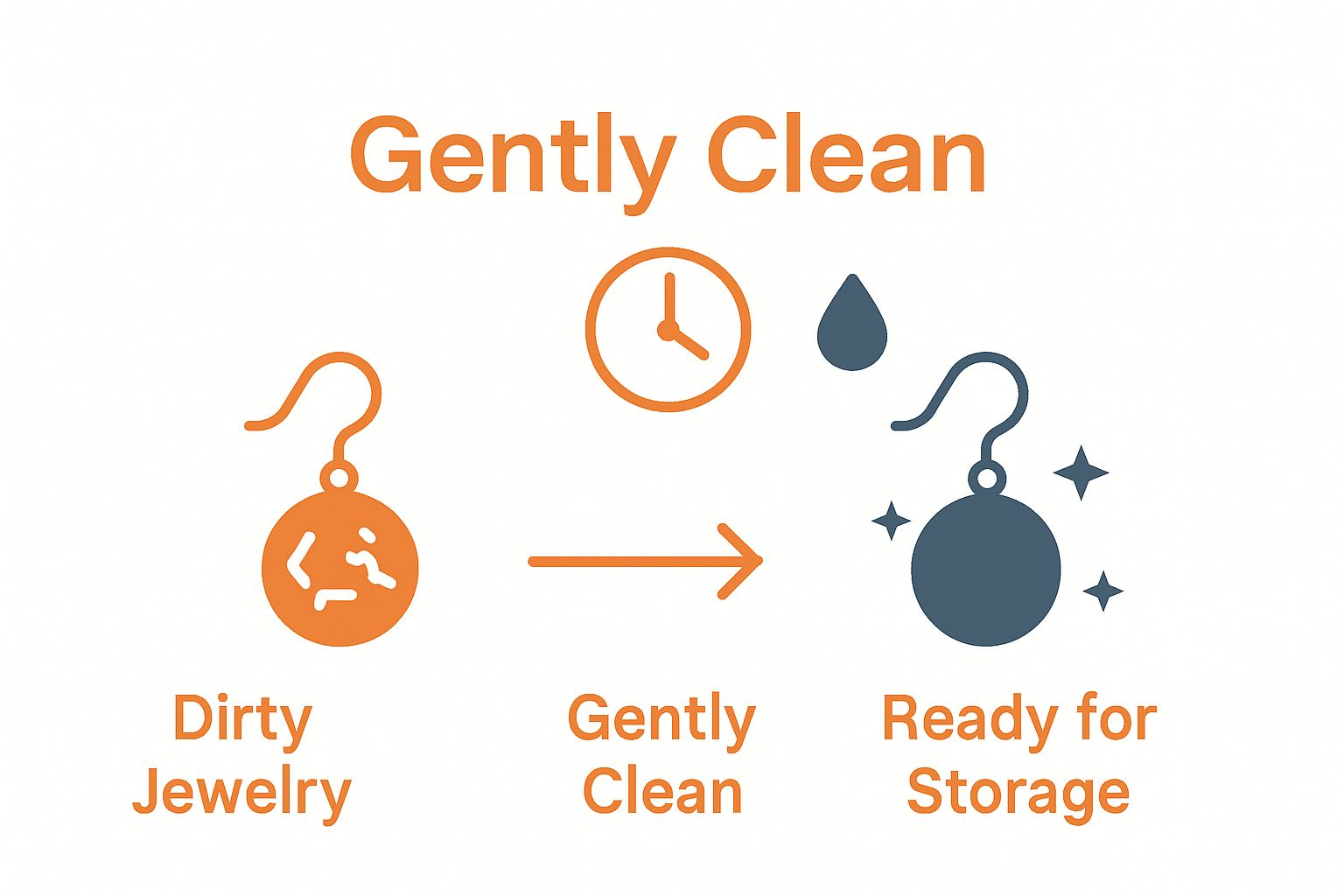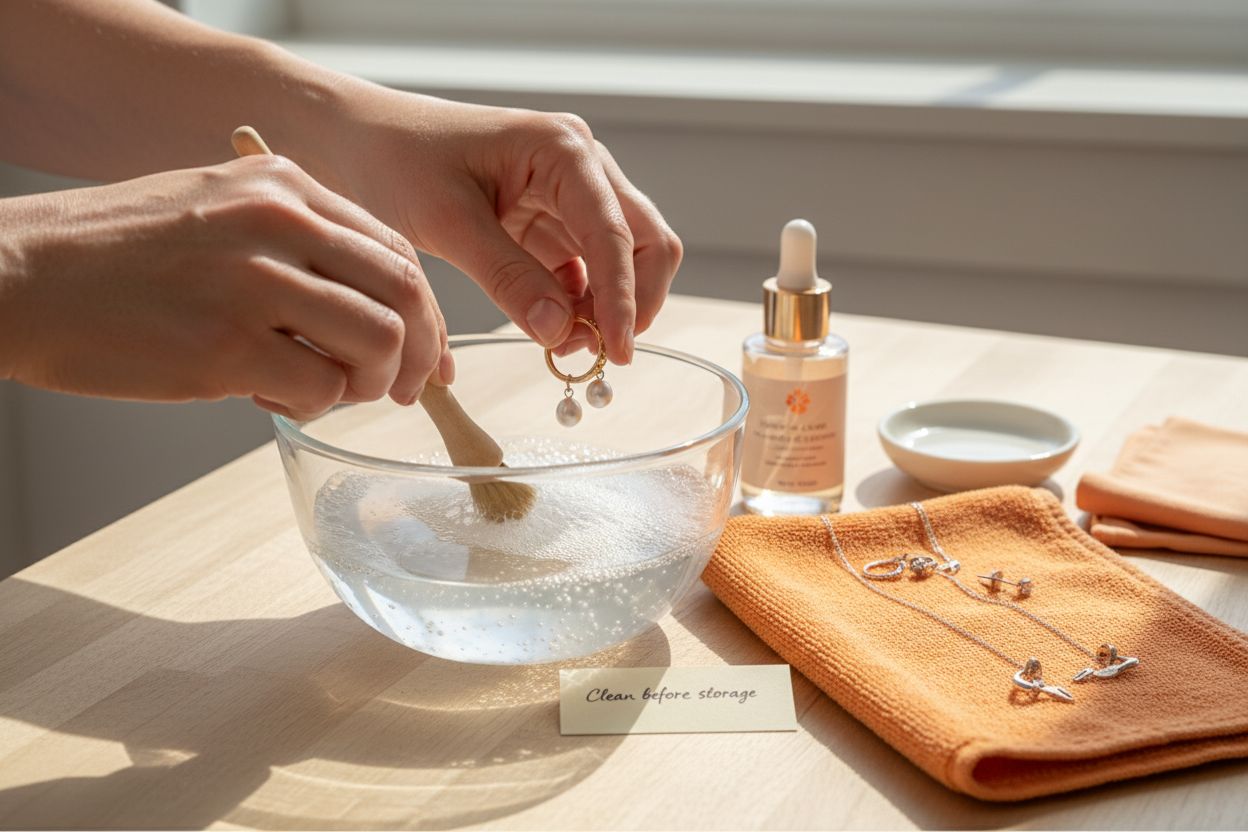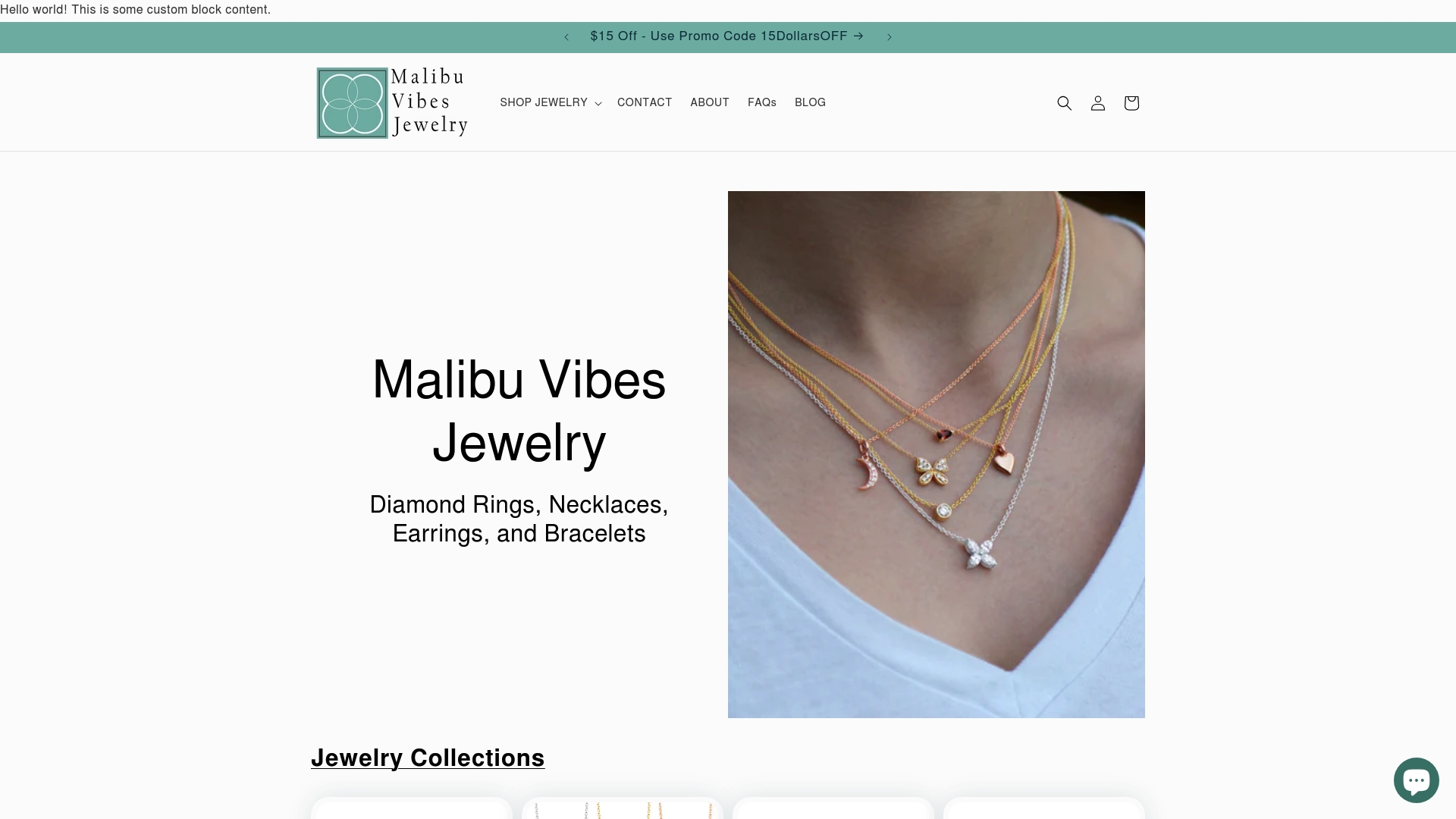Storing fine jewelry is about more than just keeping your favorite pieces in a box. Gold, silver, platinum, and precious gemstones all need completely different care routines to avoid damage. Most people think a pretty jewelry box is enough, but that simple approach can actually ruin your collection over time. Some quick adjustments can keep your valuables looking flawless for decades.
Table of Contents
- Step 1: Evaluate Your Jewelry Collection
- Step 2: Choose The Right Storage Solution
- Step 3: Clean Each Piece Before Storage
- Step 4: Organize Jewelry By Type And Frequency Of Use
- Step 5: Securely Store Jewelry To Prevent Damage
- Step 6: Regularly Check And Maintain Your Jewelry Storage
Quick Summary
| Key Point | Explanation |
|---|---|
| 1. Evaluate your jewelry collection | Assess material composition, condition, and value to determine care needs. |
| 2. Choose appropriate storage solutions | Use specialized containers to protect against damage and tarnishing. |
| 3. Clean jewelry before storage | Remove dirt and oils to prevent deterioration during storage. |
| 4. Organize by type and usage | Group pieces by metal type and frequency for easier access and protection. |
| 5. Regularly check and maintain storage | Implement a quarterly inspection to ensure pieces remain in excellent condition. |
Step 1: Evaluate your jewelry collection
Before diving into storage strategies, understanding your jewelry collection is crucial for proper preservation. Your fine jewelry is not just an accessory but an investment that requires thoughtful assessment and care. Start by gathering all your jewelry pieces in a clean, well-lit area with a soft surface like a velvet cloth to prevent accidental scratching.
Carefully inspect each piece for its material composition, condition, and sentimental or monetary value. Gold, silver, platinum, and precious gemstone pieces require different care approaches. Take note of delicate settings, potential loose stones, or existing wear and tear. For pieces with significant financial or emotional worth, consider reading our guide on jewelry appraisal to understand their true value and potential restoration needs.
Classify your collection into categories based on frequency of use, material type, and vulnerability. Separate everyday pieces from special occasion jewelry, and identify items that might need extra protection. Vintage or antique pieces, intricate designs with delicate settings, and pieces with soft or porous gemstones like pearls, opals, and turquoise demand special attention.
Document your collection thoroughly. Create a detailed inventory that includes photographs, descriptions of materials, approximate values, and any unique characteristics. This documentation serves multiple purposes: insurance protection, personal record-keeping, and helping you develop a targeted storage strategy. For high-value pieces, professional appraisal and photography can provide additional security and peace of mind.
By meticulously evaluating your jewelry collection, you’re laying the groundwork for an effective preservation strategy that will keep your treasured pieces beautiful and protected for years to come.
Step 2: Choose the right storage solution
Selecting the appropriate storage solution is critical in protecting your fine jewelry collection. The right storage approach depends on multiple factors including the types of pieces you own, their material composition, and your specific environmental conditions. Your storage strategy must balance protection, accessibility, and preservation.
Consider investing in specialized jewelry storage containers that offer multiple protective features. Hard-sided cases with soft, cushioned interiors provide superior protection against physical damage. Look for containers with individual compartments that prevent pieces from rubbing against each other, which can cause scratching or wear. Some high-quality storage solutions include anti-tarnish fabric linings that help protect silver and other reactive metals from oxidation.
For different types of jewelry, customize your storage approach. Delicate chain necklaces benefit from hanging mechanisms that prevent tangling, while rings and earrings require flat, padded surfaces with separate compartments. Stackable trays with soft dividers can help organize smaller pieces efficiently. Avoid storing different metal types together, as this can accelerate tarnishing and potential chemical reactions.
Environmental control is paramount in jewelry preservation. Research from gemological experts emphasizes the importance of maintaining consistent temperature and humidity levels. Store your jewelry collection away from direct sunlight, heat sources, and areas with significant temperature fluctuations. Ideal storage locations include interior closets or dedicated drawers that remain cool and dry. Avoid storing jewelry in bathrooms or kitchen areas where moisture and temperature changes are frequent.
For particularly valuable or sentimental pieces, consider additional protection methods. A small home safe or a bank safety deposit box can provide an extra layer of security for irreplaceable items. When traveling, use compact, padded jewelry rolls or cases that offer both organization and protection. By thoughtfully selecting your storage solutions, you create a protective environment that maintains your jewelry’s beauty and structural integrity for years to come.
Step 3: Clean each piece before storage
Preparing your fine jewelry for storage begins with thorough and careful cleaning. Dirt, oils, and residue from daily wear can gradually damage your precious pieces, causing tarnishing, discoloration, and potential long-term deterioration. Professional gemological research emphasizes the critical importance of proper cleaning before long-term storage.
Different materials require unique cleaning approaches. For gold and platinum pieces, create a gentle cleaning solution using warm water and mild, phosphate-free dish soap. Soak the jewelry briefly, then use a soft-bristled brush like a clean, unused baby toothbrush to carefully remove accumulated grime. Avoid harsh scrubbing that might loosen stone settings or scratch delicate surfaces. Soft gemstones like pearls, opals, and turquoise demand extra gentleness and should only be wiped with a soft, slightly damp cloth.

Silver jewelry requires special attention to prevent tarnishing. Use a specialized silver cleaning cloth or a solution specifically designed for silver. Gently buff the piece in one direction, avoiding circular motions that might create fine scratches. For heavily tarnished silver, consider a professional cleaning service to restore its original luster without risking damage.
Diamond and harder gemstone jewelry can tolerate slightly more rigorous cleaning. Prepare a solution of warm water and a few drops of mild detergent. Soak the pieces for several minutes, then use a soft brush to remove dirt from intricate settings. Rinse thoroughly with clean water and pat dry using a lint-free, soft cloth. Ensure no moisture remains, as water trapped in settings can lead to potential damage or accelerated metal oxidation.
After cleaning, allow each piece to air dry completely in a clean, dust-free area.
 Inspect your jewelry carefully under good lighting, checking for any loose stones, worn prongs, or signs of damage. This pre-storage cleaning not only preserves your jewelry’s appearance but also provides an opportunity to identify pieces that might need professional repair before long-term storage.
Inspect your jewelry carefully under good lighting, checking for any loose stones, worn prongs, or signs of damage. This pre-storage cleaning not only preserves your jewelry’s appearance but also provides an opportunity to identify pieces that might need professional repair before long-term storage.
To help you select the best cleaning technique for each piece, here is a comparison of cleaning methods based on jewelry material.
| Jewelry Material | Cleaning Solution | Cleaning Method | Special Care Instructions |
|---|---|---|---|
| Gold/Platinum | Warm water + mild, phosphate-free soap | Soak briefly, brush gently | Avoid harsh scrubbing, dry thoroughly |
| Silver | Silver cleaning cloth/solution | Gently buff, avoid circular motions | Seek professional cleaning for heavy tarnish |
| Pearls/Opals/Turquoise | Slightly damp, soft cloth | Wipe gently | Avoid soaking or strong chemicals |
| Diamonds/Hard Gemstones | Warm water + mild detergent | Soak several minutes, soft brush | Ensure no moisture remains |
Step 4: Organize jewelry by type and frequency of use
Organizing your jewelry collection strategically transforms storage from a basic necessity into an art form that protects and showcases your precious pieces. Learn more about distinguishing fine jewelry styles to help refine your organizational approach. The key is creating a system that prioritizes both accessibility and protection.
Begin by categorizing your jewelry into clear, functional groups. Separate pieces by metal type, preventing potential chemical interactions that could cause tarnishing or damage. Create distinct sections for gold, silver, platinum, and mixed-metal pieces. Within these categories, further subdivide by frequency of use. Your everyday pieces should be stored in easily accessible locations, while rare or sentimental items require more protective storage solutions.
Design a storage hierarchy that reflects your lifestyle and jewelry collection. High-rotation pieces like wedding bands, everyday stud earrings, and simple necklaces should be stored in top drawer compartments or hanging organizers with clear visibility. Special occasion jewelry and heirloom pieces demand more careful consideration. Use padded, divided containers with soft fabric separators to prevent scratching and minimize potential damage. Consider investing in a tiered jewelry box with multiple compartments that allows you to create a logical, visually appealing organization system.
Take special care with delicate or high-value pieces.
Vintage jewelry, items with intricate settings, or pieces featuring soft gemstones require individual soft pouches or dedicated compartments that prevent contact with other jewelry. Necklaces should be hung or laid flat to prevent tangling, while rings can be stored in dedicated ring holders or soft-lined trays. Always store earrings in pairs, using small, dedicated compartments that keep matching sets together and prevent loss.
Your organizational system should also facilitate regular maintenance. Position your storage in a location that allows easy access for periodic cleaning and inspection. By creating a thoughtful, intentional approach to jewelry organization, you protect your investment while ensuring your most cherished pieces remain accessible, beautiful, and ready to wear at a moment’s notice.
Step 5: Securely store jewelry to prevent damage
Securing your fine jewelry requires a strategic approach that goes beyond basic storage. Physical protection is just as crucial as selecting the right storage environment. Learn about the intricate details of jewelry craftsmanship to understand the delicate nature of your precious pieces and why careful handling matters.
Protective materials play a critical role in preventing scratches, tangles, and accidental damage. Invest in high-quality storage solutions featuring soft, non-abrasive interiors like velvet, silk, or microfiber linings. Individual compartments with soft dividers prevent pieces from rubbing against each other, which can cause micro-scratches and wear down delicate settings. For chain necklaces, consider specialized hanging systems or individual silk pouches that prevent tangling and minimize stress on delicate links.
Environmental factors significantly impact jewelry preservation. Keep your storage areas away from direct sunlight, humidity, and extreme temperature fluctuations. Avoid storing jewelry in bathrooms, kitchens, or near windows where temperature and moisture can cause rapid deterioration. Use silica gel packets in your storage containers to absorb excess moisture, which can accelerate metal oxidation and potentially damage gemstone settings. For silver pieces particularly vulnerable to tarnishing, consider anti-tarnish strips that help maintain their original luster.
Additional protective strategies include using padded travel cases for transportation and creating a dedicated, stable storage location. Hard-sided cases with custom foam inserts offer maximum protection during movement. At home, choose a storage area with consistent temperature and minimal light exposure. Consider a small, fireproof safe for extremely valuable or sentimental pieces, providing an extra layer of security against potential home accidents or theft.
Regular inspection is the final critical component of secure jewelry storage. Every few months, remove each piece, inspect for any signs of damage, clean gently, and reorganize. This proactive approach allows you to catch potential issues early, ensuring your fine jewelry remains in pristine condition for years to come.
Step 6: Regularly check and maintain your jewelry storage
Maintaining your jewelry storage system is an ongoing process that protects your valuable collection from potential damage and deterioration. Consistent care is the cornerstone of preserving your fine jewelry’s beauty and structural integrity. Understand the intricate components of jewelry craftsmanship to appreciate why regular maintenance is crucial.
Establish a quarterly inspection routine that allows you to thoroughly examine each piece and your storage environment. Begin by removing all jewelry from your storage containers, inspecting them under good lighting with a soft cloth beneath to catch any accidentally dislodged stones or findings. Check prong settings, clasps, and connections for signs of wear or potential weakness. Pay special attention to pieces with delicate gemstone settings or vintage jewelry, which might require more frequent professional assessment.
Rotate and redistribute your jewelry collection during these maintenance sessions. This practice prevents prolonged pressure on specific areas of your storage containers and ensures that each piece receives equal attention. Reorganize your storage compartments, replacing anti-tarnish strips, silica gel packets, and checking the condition of your protective linings. Look for any signs of material degradation in your storage containers themselves, such as fabric fraying, interior discoloration, or structural weakening that could compromise your jewelry’s protection.
Environmental monitoring is equally important during these maintenance checks. Assess the storage location for any changes in humidity, temperature, or potential exposure to harmful elements. Use a small hygrometer to track moisture levels, keeping them between 35-55% to prevent oxidation and material stress. Clean your storage containers thoroughly using soft, lint-free cloths, removing any dust or potential contaminants that might have accumulated. Consider this maintenance time an opportunity to reimagine your organizational system, ensuring it continues to meet your evolving collection’s needs.
For quick reference, here is a checklist summarizing key jewelry storage and maintenance actions to keep your collection safe and beautiful.
| Action | Description | Recommended Frequency |
|---|---|---|
| Inspect each piece | Check for loose stones, worn prongs, or signs of wear | Every 3 months |
| Clean jewelry | Use material-appropriate cleaning methods before storing | Before storage, quarterly |
| Reorganize storage compartments | Group by metal type and frequency of use, maintain clear separation | Every 3-6 months |
| Replace anti-tarnish strips/silica gel | Refresh moisture and tarnish control materials in storage containers | Every 3-6 months |
| Monitor storage environment | Ensure cool, dry conditions away from humidity and sunlight | Ongoing |
By treating jewelry maintenance as a regular, thoughtful ritual, you transform storage from a passive act into an active preservation strategy. Your commitment to consistent care will ensure that each piece remains as stunning and structurally sound as the day you first acquired it.
Preserve Your Most Treasured Fine Jewelry—Choose Quality That Lasts
You have just learned how to store and protect your fine jewelry from damage, tarnish, and loss. Still worried about tangled chains or dull metals? The right jewelry is not just about looks; it is an investment in memories and personal style that deserves the very best care. Elevate your storage ritual by choosing pieces designed for lasting beauty. Discover our Solid Gold Necklaces collection, carefully handcrafted to withstand daily wear and simple to keep safe using strategies from our guide.

Do not settle for less than excellence when it comes to preserving elegance. Take a moment to explore Bezel Jewelry known for its modern lines and secure settings that make organization a breeze. Ready to upgrade your collection or refresh your storage solutions? Visit Malibu Vibes Jewelry today for exclusive offers and the peace of mind that comes from investing in truly lasting pieces. Your jewelry deserves nothing but the best care—start now.
Frequently Asked Questions
How should I evaluate my jewelry collection before storing it?
Start by gathering all your jewelry in a clean, well-lit area and inspecting each piece for material composition, condition, and sentimental or monetary value. Categorize them based on frequency of use and vulnerability, and document everything for future reference.
What is the best way to clean jewelry before storage?
Use a gentle cleaning solution specific to each material. For gold and platinum, mix warm water with mild soap, while silver requires specialized cleaning solutions. Soft gemstones like pearls should only be gently wiped with a damp cloth. Ensure each piece is fully dry before storing.
How can I organize my jewelry effectively for storage?
Organize your jewelry by metal type and frequency of use. Everyday pieces should be easily accessible, while special occasion items need more protection. Use padded containers and hanging methods to prevent tangling and scratching.
What measures can I take to secure my jewelry from damage?
Invest in storage solutions with soft interiors to prevent scratches and tangles. Keep your jewelry in a cool, dry place away from direct sunlight. Use silica gel packets to control humidity and conduct regular inspections to catch any signs of damage early.
Recommended
- What is Fine Jewelry? Understanding Luxury and Craftsmanship – Malibu Vibes Jewelry
- 7 Key Differences Between Fashion Jewelry vs Fine Jewelry – Malibu Vibes Jewelry
- Understanding Jewelry as an Investment: Key Insights – Malibu Vibes Jewelry
- What is Jewelry Appraisal? Understanding Its Importance – Malibu Vibes Jewelry



